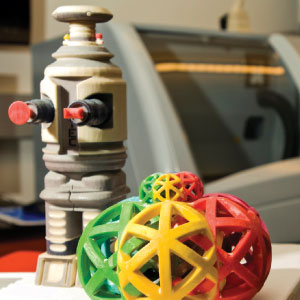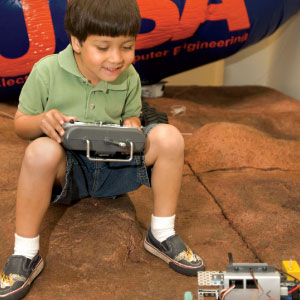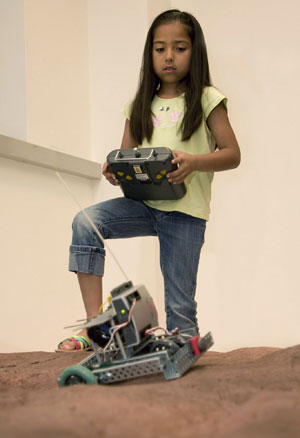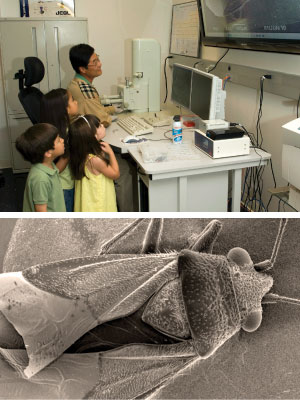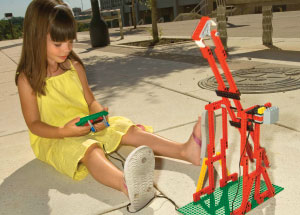Feature
The Fun Factor
The Interactive Technology Experience Center inspires students to pursue science, technology, engineering and math
It was July 20, 1969. As Neil Armstrong became the first man to walk on the moon, 10-year-old Mauli Agrawal listened transfixed to his family’s radio in India. He knew he was listening to history being made.
And that excitement lingered, eventually spurring him to become an engineer.
“I grew up on the other side of the world, and the excitement was there,” said Agrawal, dean of the College of Engineering. “It wasn’t just a U.S. thing, it was a human thing. We were going to the moon.” He later collected magazine pictures of the moon landing that he converted into posters for his room.
Forty-one years later, another 10-year-old, Christian Castillo, expertly navigates a small robot with a bulky remote controller, similar to a remote controlled car. He is in UTSA’s Interactive Technology Experience Center, or iTEC, a showroom dedicated to students from kindergarten to 12th grade. The center was created under Agrawal’s direction to inspire students to pursue careers in science, technology, engineering and math, also called the STEM fields.
Agrawal, who holds the Peter Flawn Professorship in Biomedical Engineering and the David and Jennifer Spencer Distinguished Dean’s Chair in Engineering, hopes that experiences with robots, a high-powered microscope and other technologies never before seen by these students will give them that “moon-landing” moment. And from the look of Christian, it’s working.
“We want to create this excitement all across the city, especially in the population that we serve, which is a lot of first-generation and underrepresented students,” Agrawal said. “And we need to get to them early in their lives to encourage them and to make them believe that they can be engineers. They can be inventors. It’s not just for somebody else; all of them have the capability.”
The showroom is about the size of a one-room apartment, slightly less than 900 square feet, nestled on the first floor of the Applied Engineering and Technology (AET) Building. But inside is almost $400,000 worth of equipment, making it look more like a Best Buy than a university classroom. Along three walls are 65-inch mounted flat-screen televisions. There are computer monitors on every table lining the walls, a rapid prototyping machine linked to a 3-D printer, and a highpowered electron microscope, powerful enough to see the eye of a fly magnified 10,000 times. A rugged floor mat, made to simulate Mars’ terrain, lies in the back of the room, ready to be explored by a miniature Mars Rover.
And everything, though capable of aiding any faculty researcher, is just for kids.
“Researchers fight to use [the microscope], but we’re keeping them at bay and we tell them, ‘You cannot use it. It’s only for the kids,’” Agrawal said.
In 2007, the AT&T Foundation gave $1.5 million to UTSA to create iTEC. As part of a four-year project, faculty and staff develop programs and learning curriculums, give demonstrations and host robotics competitions and summer camps. Everything centers around robots, telecommunications, scanning electron microscope applications and design for manufacturing.
“AT&T has a lot of engineers that we utilize in our business,” said Michelle Thomas, assistant vice president of external affairs for AT&T. “One of the things we had noticed was a trend in education. There were not as many people going into the fields of engineering and mathematics and science.” Because of that, the company initiated AT&T Aspire, which will give $100 million to programs like iTEC throughout the U.S.
The idea is simple: make science, technology, engineering and math fun. “We don’t want them to think that engineering is a geek thing,” said iTEC director Can Saygin.
In fact, this effort is critical to the country. The U.S. continues to lag far behind the rest of the world in the number of people trained in STEM fields. Simultaneously, developing countries are beefing up their interest in these areas. As America loses its competitive edge, a decline in the number of jobs available in the country follows. Along with that comes a drop in average household income.
“If you think of the long-term welfare of our country and how do we stay No. 1, it’s because of the technology and ingenuity and inventorship that is here,” Agrawal said. “The new big thing usually comes out of the U.S. If we don’t have a pipeline of [students] going into these areas, that will dry up.”
That pipeline is exactly what iTEC is helping to establish. The key to maintaining the nation’s technological edge is to entice students into STEM fields when they’re young. By keeping them interested—and properly educated—those students are more likely to enter into STEM careers. If educators wait until high school or college to appeal to them, it’s already too late.
“It’s harder for high school students to switch gears from fireman to engineer,” said Moses Thompson, iTEC program manager.
So iTEC managers have done what any parent, desperate to capture a child’s interest, would do. They’ve learned to embrace the art of play
In the center, there are Lego robots and sumo robots. There are blimps. There are bugs—flies, ants and anything else that can be caught—waiting for magnification. And there’s that printer, which can build anything a child can imagine—from a soda can to a geodesic sphere—one colorful layer at a time.
“Though iTEC stands for the Interactive Technology Experience Center, we have another name for it—involve, teach, excite and challenge,” Saygin said. “So we get them involved, they get excited so we can teach them a little bit, and then we challenge them with competitions. This is our educational version of iTEC.”
Making a difference
When iTEC organizers decided to host their first summer robotics camp last year for students in third to eighth grade, they offered it for free. It was new and unknown to schools in the city. They needed experience running a camp. And most of all, they needed students.
Within 24 hours of posting the camp registration online, 372 students had signed up, with another 300 bumped to a waiting list. Organizers scurried to buy enough laptops, robot kits and food.
“That was one of the most exciting weeks of my academic life,” Saygin said.
So this year they’ve limited the number and are charging a small fee—$70—to keep things manageable. But the unexpected response from last year speaks to the need for similar programming, said Mary Stowers, educational specialist for iTEC.
“In schools, the only kids for the most part that get access to robotics are the GT [Gifted and Talented] kids,” she said. “There are a whole lot of smart kids out there that are not in GT programs. The late bloomers do not get a chance at something like this in the traditional school system. They can be bright, but for whatever reason they are not on the radar screen yet.”
Having a chance to work with university researchers, undergraduate and graduate students, and high-tech equipment that costs more than some of their homes can be life-altering for the kids, iTEC managers said.
“We definitely changed some lives,” Thompson said. “These are kids who would never have had an opportunity to do something like what we’ve offered here. They would never have stepped out of their comfort zone.”
That was the case for one Dellview Elementary School student. Diagnosed with autism, he had never spoken to his teachers in three years. He never made eye contact. Then, just two days before the end of the camp, he walked up to Thompson, looked him in the eyes and said, “Thank you for letting me do this.”
“I witnessed it and it gave me goose bumps,” Saygin said. “I said, ‘Wow, that’s how we make a difference.’ It’s amazing.”
In addition to summer camps, iTEC also is the host of the Getting Excited About Robots (GEAR) competition, which this year featured nearly 600 third- through eighth-graders divided into 117 teams, making it the largest all-American robotics competition for children in the nation. Next year, iTEC is scheduled to host a regional FIRST (For Inspiration and Recognition of Science and Technology) robotics competition.
“It’s fun,” Agrawal said. “We wouldn’t be doing all this if we weren’t excited about it.”
The fact that they do it at all surprises many parents, who assume a university is only for higher education and research. But a university, especially one on the trajectory of becoming a Tier One university, is exactly the place for reaching out to younger students, he said.
“If there is one common thing that all parents say, it’s not about technology, it’s not about iTEC. They say, ‘I didn’t know UTSA did all these things,’ ” Saygin said.
In 2009, UTSA was identified as one of seven contenders to be ranked a Tier One university in Texas, also known as a premier national research university. That lofty status is measured by research expenditures, faculty publications, research citations, patents, new technology development and the number of research-oriented faculty, doctoral programs and postdoctoral trainees. In the midst of the hotly contested race to Tier One, Agrawal, Saygin and their crew are devoting time, money and badly needed infrastructure toward the youngest of students. And this is precisely what a Tier One school does, they said.
“It’s not just the classrooms, but it is the outreach into the community, the pipeline,” Agrawal said. “These are the facilities that a Tier One [school] has. The fact that all the community can come here and witness that, I think, is a big plus.”
Caught in the web
Thirty minutes after Christian Castillo picked up the remote control for one of the many robots on display in the iTEC showroom, his father, J.L. Castillo, finally managed to pull him away.
The Castillo boys, including 15-year-old Alberto, played hooky from school on a Friday in April so they could tour the new AET Building, talk to professors and learn about engineering.
“If I can get Legos and science together, I’m going to succeed in getting him into science and engineering one day,” Christian’s father said.
For the 10-year-old, engineering has always seemed so, well, boring. But after spending a morning playing with robots, he has another perspective.
“I didn’t think that engineering was fun,” he said. “I thought engineers built cars and stuff like that, but it is pretty fun. You can do a lot of stuff.”
Stowers said hooking students like Christian when they’re young is both the challenge and the joy of her job.
“The beauty of it is that you are out there,” Stowers said. “You don’t know whose life you’re going to change. You don’t know where you’re going to make that impression, which means you have to go in 110 directions because you don’t know who is going to be caught in the web. It’s often the most unexpected child that’s caught.”
And even if some students don’t end up attending UTSA, Thompson said their job is done as long as one thing is accomplished: “Curiosity. I hope to spark curiosity.”
—Lety Laurel

